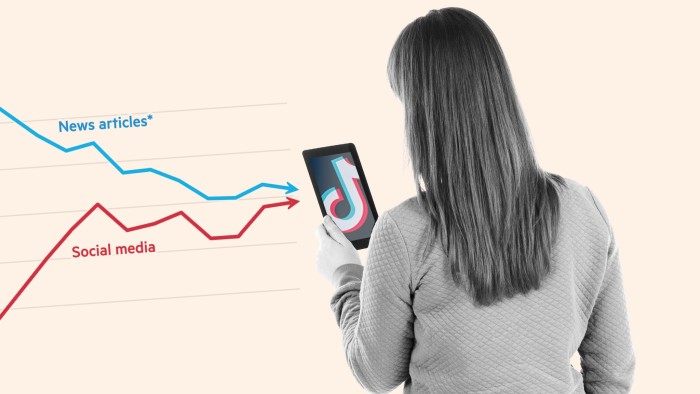Physical Address
304 North Cardinal St.
Dorchester Center, MA 02124
Physical Address
304 North Cardinal St.
Dorchester Center, MA 02124

Unlock Editor’s Digest for free
Roula Khalaf, editor of the FT, picks her favorite stories in this weekly newsletter.
Commuting on public transport has always provided a convenient opportunity to assess changing forms of media consumption. Seventy years ago, you would see a head buried in the sea newspaper. From about 15 years ago, it was glued to the screen. At first glance, today’s picture is similar, but it misses a subtle difference. Previously those screens tended to show sound; Now you get glimpses of the story in a never-ending stream of bite-sized videos.
The latter shift may seem more subtle than the former, but I’m not sure that’s true.
Print has declined over the decades, but cratering is perhaps less appreciated in any written news use. Since 2013 the share of adults reading news articles online in the US has dropped from 70 to 50 percent. The share of Britons and Americans who do not use any traditional media has now risen from 8 to nearly 30 percent when decrease While print was mainly a problem for newspaper bottom lines, declining consumption of all news was a problem for society.
Social media now dominates. Today, US adults under the age of 50 are more likely to get their news directly from social feeds than from print or online news articles, according to the latest data from the Reuters Institute for the Study of Journalism. Digital News Report. The trend in other countries is similar.

These changes have significant consequences, some of which we are only beginning to appreciate.
At a basic level, the move from a few hundred word articles to 280 characters in the 2010s meant a shift from the detail and nuance of the average news report to an oversimplified world. Don’t get a glimpse of the trade-offs and complications.
It’s not just about the short format. Instant feedback in the form of number of likes and shares has taught people quickly which is usually the best-performing content Exaggerated and hostile Rather moderate and concise. The emerging media landscape becomes hostile to an educated centrist establishment, but a boon to populists and radicals.
The latest phase of digital media transformation, the rapid rise of short-form videoArguably an even bigger step change. Platforms like TikTok and Instagram have now dwarfed Facebook, X and Bluesky among the youth, and the same shift is underway among adults.

These platforms are fundamentally different. Text-based social media still supports mainstream journalism, in part because accurate writing helps — and chronological feeds reward news. With the pivot in the video, the balance tilts the other way. On TikTok and Instagram, the currency is charisma, power and delivery: being first is less important than being hyper-fun.
This comes on top of more Reuters data showing that while social media is beginning to cannibalize news websites, most Featured news accounts Text-based social platforms still had mainstream journalists and news organizations. In video land, people can turn to influencers and content creators over traditional sources, not just for lifestyle content but for news.
This is another thumb on the scale for political outsiders. Upstart media is by definition less comfortable with established politicians, and independence from big legacy brands means it’s free to host and publish things that mainstream media won’t. Research shows the most recent class of news influencers Lean slightly to the right But their politics differ in terms of their politics Anti-establishment.
Changes in how people listen to news are part of the same pattern. Podcasts, where the norm is personal listening via earphones, are a very different animal from radio, whose culture and content were created in an era where a couple or a family could listen together in the car or the kitchen. This facilitates both a more fragmented landscape and a greater comfort with discursive output. This is much easier for the often iconoclastic nature of digital media “Manosphere” Bloomed in this world compared to the old one.
In form and function, tone and built-in incentives, the emerging media landscape of 2024 is very different from that of 2014, let alone 2004 or 1994. It would be strange indeed if it did not influence our politics